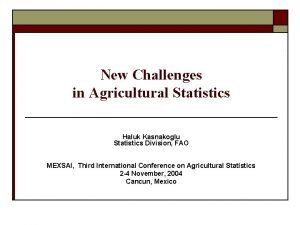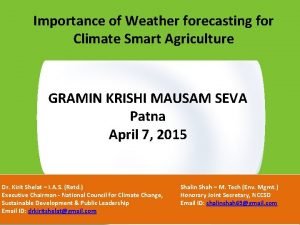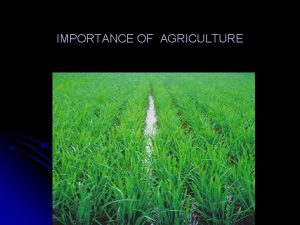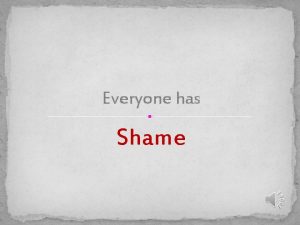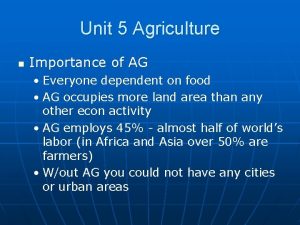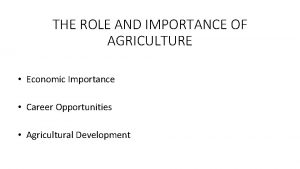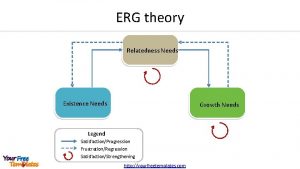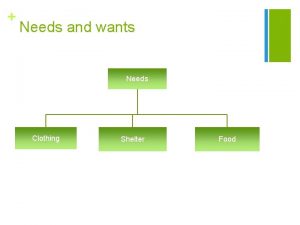The Importance of Agriculture Everyone Needs Agriculture I











- Slides: 11

The Importance of Agriculture Everyone Needs Agriculture

I Don’t Need Ag. . . Do I? You only need agriculture if you. . . • need to eat • like to wear clothes • want to have shelter • need things to sleep on • want to have things to play on and with • use medicine, make up, or soap.

Do You Realize How Much You Depend on Ag for Everyday Life? • sheets, pillows, sunscreen, shampoo, make up, lotions, nail polish, toothpaste, toilet paper • books, chalk, desks, crayons, pencils, paper • shoes, clothes, belts, sports equipment • carpeting, lumber, paints, brushes, tool handles, candles • shatterproof glass, fuel, antifreeze, tires, upholstery • detergents, lubricants, solvents • paper, ink, film, packaging

Oh, and don’t forget about. . . food! • steaks, pork chops, hamburgers, bacon, hotdogs, tacos, pot roasts, ribs, BBQ, sausage, pepperoni, ham • bread, cereal, grits, oatmeal, bagels, pancakes, waffles, muffins, fruit, eggs, cream cheese, biscuits • peanut butter, jelly, honey, syrup, ketchup, mustard, mayonnaise, salad dressing • milk, cheese, butter, yogurt, ice cream, buttermilk • salads, vegetables, soda, tea, coffee • sugar, herbs, spices

Agriculture as an Industry • “Farming” is only the production part of agriculture. • Producing the food or product is only one part of the industry. • Think of all the people employed to process, package, market, and distribute the finished products.

Agriculture also includes: • services: provide services that are needed by the producer (ex. crop spraying, veterinary work, etc. ) • processing: making the product usable for consumers (you) • packaging and distribution: getting the processed product to the consumer • marketing: promoting the product to wholesalers, retail buyers, and their customers • sales: making the product available to the consumer

How many steps does it take to make a single product? 1. The farmer grows the plants or raises the animals. 2. Businesses must supply materials and services to the farmers so farmers can raise the animals. 3. Farmers sell their crops and animals to a manufacturer to be turned into finished products. 4. The manufacturer processes, packages, and labels the goods. 5. An advertising company is hired to market the finished product to consumers so they will buy it. 6. The finished product is shipped by truck, train, or boat and stocked into stores around the world.

The Agriculture Process production processing marketing distribution

An Important Industry • It is the largest industry in the U. S. accounts for about one-eighth of the U. S. gross domestic product ($1. 26 trillion in 2000) and employs just over one-sixth of the U. S. civilian labor force (24. 1 million workers). • As of 2007, there were 2. 2 million farms, covering an area of 922 million acres, an average of 418 acres per farm. • U. S. farmers produce about $100 billion worth of crops and another $100 billion worth of livestock each year.

Ag is a Global Market • Almost $50 billion worth of agricultural products are exported each year, helping to offset trade deficits in other sectors of the economy. • The U. S. produces almost half of the world’s corn and soybean crops. • Cotton is grown in only 17 southern states which produce over 20% of the world’s cotton with annual exports of more than $3 billion and harvesting 7. 2 billion pounds of cotton each year.

A Better Life Through Agriculture How we produce food and live is changing through science and technology. • In-cab GPS and on-tractor sensors allow for more precise planting, spraying, and harvesting. • Fuels made from renewable resources (crops). • Crops that are need less water or can withstand frost or floods mean fewer losses for farmers. • Seafood grown in fresh water is a sustainable product that is better for the environment. • Foods that can deliver vaccines or provide a nonallergenic product.
 Afternoon everyone
Afternoon everyone National board amazonweise yorktimes
National board amazonweise yorktimes Everyone needs compassion
Everyone needs compassion Cybersecurity and cyberwar: what everyone needs to know
Cybersecurity and cyberwar: what everyone needs to know Everyone needs compassion
Everyone needs compassion Strategic gender needs and practical gender needs
Strategic gender needs and practical gender needs Primary needs and secondary needs
Primary needs and secondary needs Wants in esp
Wants in esp Primary needs and secondary needs
Primary needs and secondary needs Primary needs and secondary needs
Primary needs and secondary needs 10 importance of agriculture
10 importance of agriculture Importance of weather and climate to agriculture
Importance of weather and climate to agriculture










